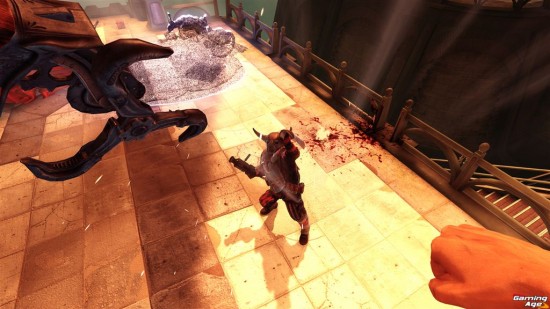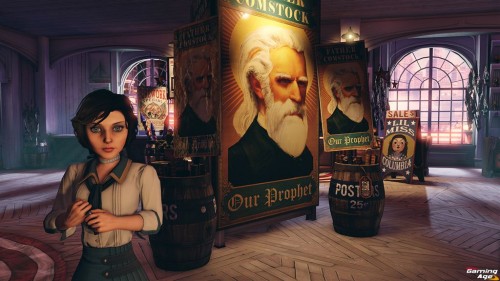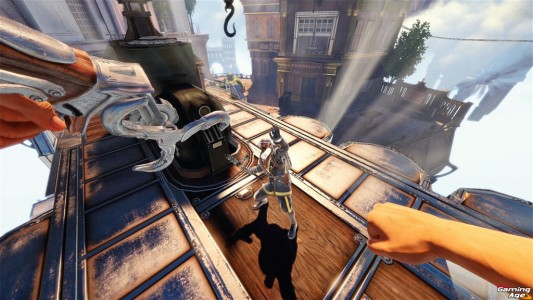Also On: PS3, PC
Publisher: 2K Games
Developer: Irrational Games
Medium: DVD-Rom
Players: 1
Online: No
ESRB: M
Bioshock Infinite is a difficult experience to accurately review without going overboard on the details that really make it such a memorable game. There?s a lot of late game moments, with an ending that certainly makes up for any shortcomings found in the original Bioshock, that just drives home the thought that you?ve seen the credits roll on something unique and special. There are bits and pieces surrounding the gameplay that aren?t entirely fun throughout, but the game as a whole is pretty fantastic.
The majority of the game surrounds the floating city of Columbia, set against the backdrop of American culture in the early 20th century. Columbia has annexed itself from the rest of the United States after a falling out stemming from the Boxer Rebellion in China. The self-proclaimed Prophet Comstock, spiritual and literal leader of Columbia, takes his ball and goes home by ascending Columbia and its citizens into the sky, never to be seen again.
 You play the role of Booker DeWitt, a down on his luck private investigator with a serious gambling problem. You?re given the offer to enter Columbia in order to bring back a mysterious young woman named Elizabeth for reasons not entirely clear. If you?re successful, you?ll wipe away your debts, allowing you the potential to live free of your crippling addiction.
You play the role of Booker DeWitt, a down on his luck private investigator with a serious gambling problem. You?re given the offer to enter Columbia in order to bring back a mysterious young woman named Elizabeth for reasons not entirely clear. If you?re successful, you?ll wipe away your debts, allowing you the potential to live free of your crippling addiction.
On the surface level, this description sounds like your typical fantasy infused trip through standard video game trappings. And from a gameplay perspective Bioshock Infinite is somewhat run of the mill. The Bioshock name is on full display throughout most combat situations though. Plasmids are replaced functionally by Vigors, some of which contain the same elements and concepts found in the original game. You can still light pools of gasoline or oil on fire, electrify water to kill off aggressive enemies, and will be able to upgrade both powers and weapons over time.
 Gunplay also feels remarkably similar, and consists of familiar weapon archetypes like pistols and shotguns. There are a few outliers, but by and large you?ll understand the appropriate use of most weapons featured if you?ve ever played a first person shooter before. There?s definitely some newer elements introduced though, like the use of ?skyrails? for both transportation and combat. These rails run across the heights of Columbia?s various sections, and allow you to move quickly from one area to the next via a skyhook earned early on, which doubles as a melee weapon.
Gunplay also feels remarkably similar, and consists of familiar weapon archetypes like pistols and shotguns. There are a few outliers, but by and large you?ll understand the appropriate use of most weapons featured if you?ve ever played a first person shooter before. There?s definitely some newer elements introduced though, like the use of ?skyrails? for both transportation and combat. These rails run across the heights of Columbia?s various sections, and allow you to move quickly from one area to the next via a skyhook earned early on, which doubles as a melee weapon.
During combat you can target enemies while riding a skyrail, and drop down for a vicious melee strike, or simply shoot from the safety of the rails with a lock-on mechanic available. Understanding and mastering the use of skyrails can make combat shift from an average experience against decent A.I. controlled enemies to a more dynamic, enticing affair that remains exciting throughout. It took a while for it to really click, but once it did I took advantage of them at every given opportunity.
 There are other similarities to the original Bioshock found throughout Infinite?s campaign, enough so that you?ll have little trouble drawing comparisons between the two. While Rapture was certainly a more terrifying place, preying both on the fears of drowning and claustrophobia amongst madmen and psychopaths, Columbia?s inner evil isn?t as much on the surface as it is just bubbling beneath the brightly lit, clean streets you?re first introduced to.
There are other similarities to the original Bioshock found throughout Infinite?s campaign, enough so that you?ll have little trouble drawing comparisons between the two. While Rapture was certainly a more terrifying place, preying both on the fears of drowning and claustrophobia amongst madmen and psychopaths, Columbia?s inner evil isn?t as much on the surface as it is just bubbling beneath the brightly lit, clean streets you?re first introduced to.
And I think the game is better for it. I found myself enamored with the game early on, after Booker first steps foot on the streets of Columbia and you get your initial reveal that not everything is what it seems. Barring previous knowledge of Elizabeth and her abilities shown in trailers in other footage, Columbia looks fairly normal when you arrive, outside of the whole floating city thing. When you begin to walk down the streets of the city everything appears to be normal, just taken from a different time period. But when you encounter a barbershop quartet, and realize that the song they?re singing sounds awfully familiar, you?ll start to realize that there?s something not quite right here.
 What really sells me on Columbia as a location, and the characters within as believable inhabitants, is the amount of detail given to bring Columbia to life. I don?t necessarily think that Bioshock Infinite is a visual powerhouse; there are some textures and character models that don?t look that great on the Xbox 360 version I played through. But it?s hard to knock the excellent art design, detail given to architecture, and all the little bits and pieces that go into making Columbia far more believable than any city floating in the sky should be.
What really sells me on Columbia as a location, and the characters within as believable inhabitants, is the amount of detail given to bring Columbia to life. I don?t necessarily think that Bioshock Infinite is a visual powerhouse; there are some textures and character models that don?t look that great on the Xbox 360 version I played through. But it?s hard to knock the excellent art design, detail given to architecture, and all the little bits and pieces that go into making Columbia far more believable than any city floating in the sky should be.
This is also aided by Elizabeth, the young woman you?re first tasked with retrieving. She?ll accompany you throughout the majority of the game, with some interesting reactions and interactions depending on the current situation. She?ll offer up found money, health, and ammo if you?re running low, and point out the occasional lockpick, giving her some useful gameplay elements. She also doesn?t need to be babysat, staying out of harm?s way and offering up unique abilities that can aid you in combat situations. I wasn?t quite as invested in her as I have been in characters like Alyx from Half-Life 2, or Yorda from Ico, but she certainly helps to sell the overall experience in a meaningful way.
Again, Bioshock Infinite?s real meaningful moments are better realized once you?re finished with the campaign. There?s enough present while playing to keep you engaged and excited to keep pushing forward, but realizing how all the little details that you?ve uncovered tie together in ways that weren?t entirely evident at first is pretty incredible. It?s a well-crafted experience that?s certainly more than the sum of its parts, even if those parts are by and large pretty damn good. It?s a satisfying and intriguing experience from top to bottom, and something that?s well worth checking out.

